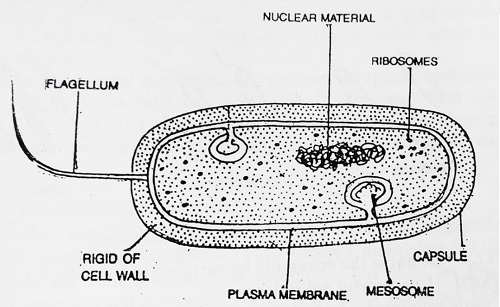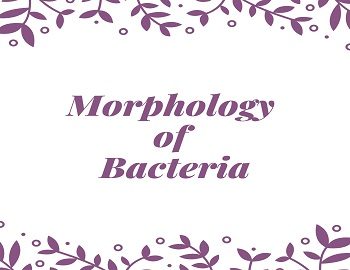Morphology of Bacteria:
Antonie Van Leeuwenhoek was the first to describe the morphology of bacteria. They may be rod-shaped called bacilli or spherical called cocci and their size depends on the shape. The structure of a bacteria cell can be described as under-

- Capsule– surrounds the cell wall and is a thick coat of gelatinous material. It may be diffused to be called Slime Layer. It is compared largely to polysaccharides and serves as an additional protective layer.
- Cell Wall- consists of a single layer and is made up of a nitrogenous substance called Chitin. The cell wall of certain bacteria shows a characteristic reaction to the stain devised by C.Gram. Those bacteria which retain the stain are known as Gram-positive and those bacteria which do not retain the stain are called Gram-Negative. Chemically, the cell wall contains N-acetyl glucosamine and diaminopimelic acid.
- Cytoplasmic Membrane- is a thin, delicate, permeable cell membrane just beneath the cell wall.
- Mesosomes- are vesicular, convoluted structures formed by the invaginations of the plasma membrane in the cytoplasm and function like that of mitochondria and are the sites of respiratory enzymes in bacteria.
- Ribosomes- are small dot-like structure scattered throughout the cytoplasm and help in protein synthesis. They may occur in series forming polyribosomes.
- Metachromatic Granules or Chromatophores- are present in photosynthetic bacteria and contain photosynthetic pigments.
- Gas Vacuoles- are present in certain bacteria. There are filled with gases and help bacteria to float or sink.
- Nucleus- The bacterial nucleus is not surrounded by a nuclear membrane and does not have nucleolus. The genome consists of a single molecule of double-stranded DNA arranged in the form of a circle. It may open under certain conditions to form a long chain of about 1000 microns. Bacteria may sometimes have extranuclear genetic material called plasmid or episome because of which some bacteria show toxicity and drug resistance.
- Flagella- are long sinuous contractile filamentous appendages and arise from the basal body just inside the cell wall and contain a cavity. They are organ of locomotion and are also antigenic. The number and arrangement of flagella are characteristic of each bacterium.
- Fimbriae or Pili- project from the cell surface as straight filaments. They are smaller and thinner than flagella and do not contain a cavity. They are organs of adhesion and conjugation.









Comments (No)